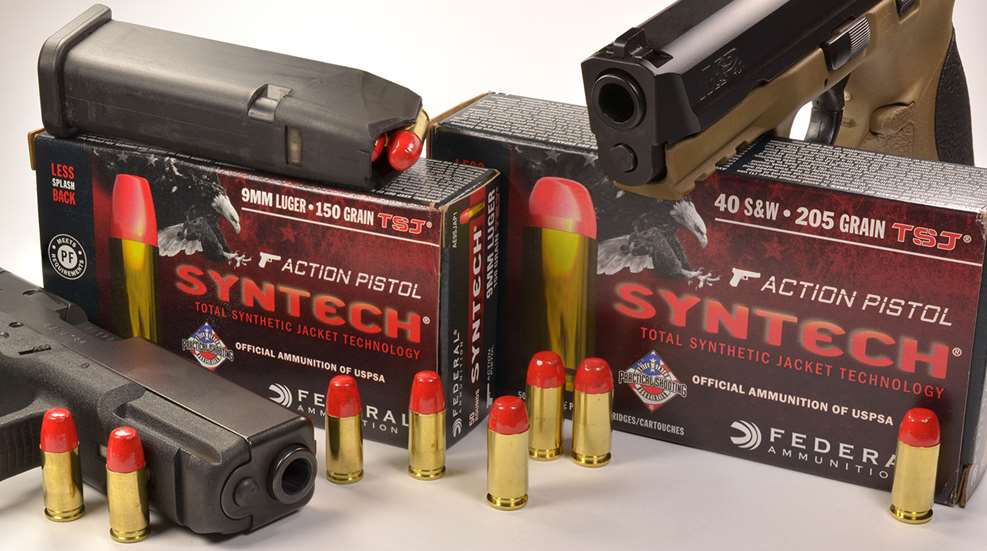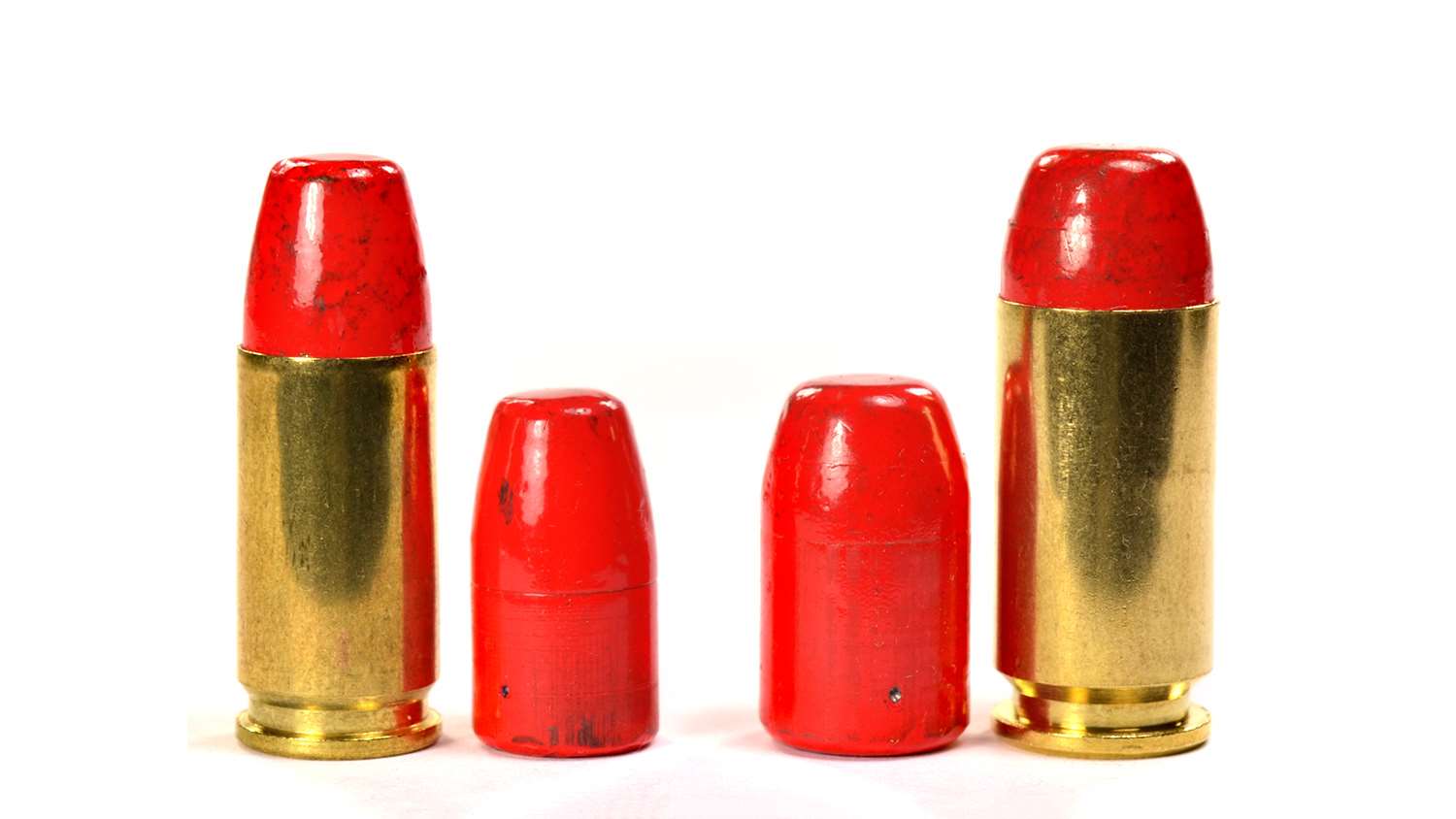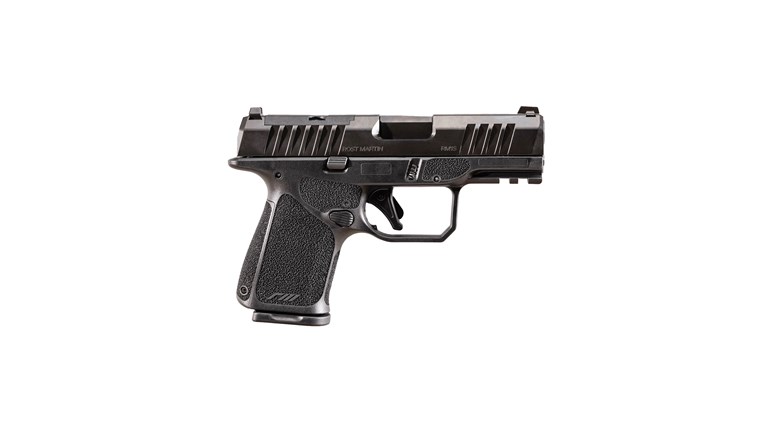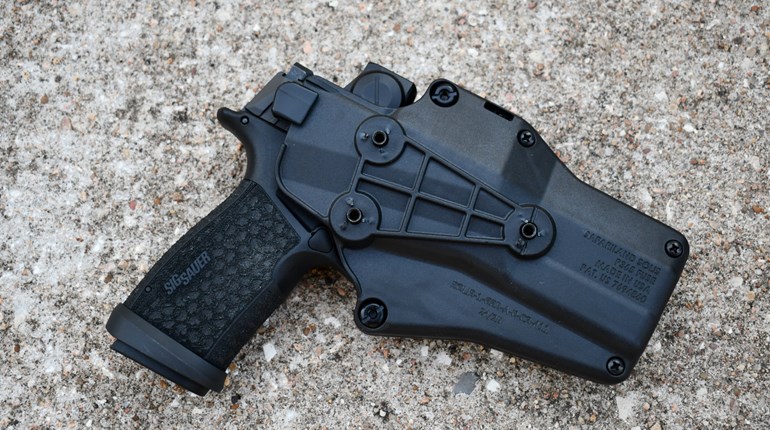
Federal recently added a new version of their Syntech Total Synthetic Jacket (TSJ) bullets optimized for action shooting sports. Three loads, one each in 9mm Luger, .40 S&W and .45 Auto, are recognized as official ammunition of the USPSA (United States Practical Shooting Association), the U.S. division of IPSC (International Practical Shooting Confederation). Of course, the ammo is also ideal for NRA Action Pistol (Bianchi Cup National Action Pistol Championship), IDPA (International Defensive Pistol Association), or any other shooting.
The Action Pistol load in .45 Auto has been previewed in other articles, but I could not locate any, and it was not on Federal’s website at the time the 9mm and .40 S&W were available. It reportedly has a 220-grain round nose bullet that clocks at 790 fps for a 174 power factor. For this article, the 9mm and .40 S&W loads are reviewed.
The TSJ bullets are soft lead coated with a red proprietary polymer. The polymer coating acts as a lubricant and prevents metal on metal contact between the bullet and bore which reduces wear and friction. The polymer fully encapsulates the bullet, including the base, thereby eliminating airborne lead that would be vaporized by the hot gases from the base of bullets with exposed lead. Federal uses special lead-free Catalyst primers, which should virtually eliminate airborne lead particles. They have a clean burning propellant to reduce residue. Since these are soft lead bullets, they disintegrate when hitting steel targets and reduce splash-back.
The 9mm Luger has a 150-grain TSJ bullet with an advertised velocity of 870 fps, which yields a power factor of 130. It is designed to meet a minimum power factor of 125 required for Minor power factor scoring, and a 130 power factor provides a little extra velocity buffer to ensure qualifying. The 150-grain TSJ ammo produces a slightly lower power factor than typical off-the-shelf ammo. For example, a 115-grain bullet in 9mm Luger usually runs a power factor around 135 or higher (e.g. 115-grain at 1180 fps = 135 power factor), and a 147-grain bullet traveling at 990 fps produces a 145 power factor.

The 40 S&W ammo has a 205-grain TSJ bullet with an advertised velocity of 830 fps for a 170 power factor. The .40 S&W load is designed to meet a minimum power factor of 165 to qualify for Major scoring. Factory ammunition in this caliber often runs a 180-grain bullet around 1000 fps, which produces a 180 power factor.
A lower power factor means less recoil for less muzzle rise and faster follow-up shots. The use of heavy bullets means a softer feeling recoil impulse—more of a push and less of a snap like lighter bullets feel. How does that work? When bullets of different weights are loaded to the same power factor with the same powder, the heavier bullets produce less recoil force because they use measurably less powder1. The softer push recoil from heavy bullets is thought to result from their slower acceleration, because they don’t have to exit as fast as lighter bullets to reach the same power factor. Slow and heavy bullets produce a perceptible reduced and softer recoil impulse than light and fast bullets.
Both bullets are flat nosed, and Federal says they are flatter than typical nose profiles for better energy transfer to steel targets.
A bullet was pulled and measured, as was the powder charge. Bullets were identical or nearly identical to their advertised weights. The 9mm load was powered by 3.0 grains of powder, and the .40 S&W load by 4.0 grains of powder. The low powder charge weights used in these loads aid in keeping recoil low because the weight of the powder influences the recoil force. Powders that require more weight for the same velocity produce more recoil force because the weight of the powder is part of the ejecta that exits the barrel, and more ejecta weight out the barrel means more recoil force backwards on the gun and the lucky person holding it. You can thank Sir Isaac Newton and his third law of motion for the recoil and the principle of the conservation of mass for adding in the weight of the gunpowder. Physics is fun, eh?

The 9mm load was fired from a 4-inch Glock 19, and the .40 S&W load was fired from a 4.25-inch S&W M&P for velocity. Published velocities are from a 4-inch barrel. The 9mm load produced 870 fps and a 130 power factor from the Glock, exactly matching the published speed. The .40 S&W load produced 816 fps and a 167 power factor from the S&W. This is a little lower than the published speed, and it drops the power factor a little close to the 165 minimum. Some barrels are “fast,” and some are “slow,” and mine might be on the slow side. Even so, it achieved power factor!

Recoil was light with these loads compared to common full power ammunition. I compared the felt recoil with Remington 147-grain FMJ ammo for the 9mm and Winchester 180-grain FMJ ammo for the .40 S&W. The Federal Action Pistol loads clearly had less felt recoil. I even ran some of Federal’s other Syntech ammo along side the Action Pistol brand. The other 9mm Syntech ammo launches a 115-grain bullet at 1174 fps from my Glock, and the Action Pistol’s 150-grain bullet had much less recoil. Federal’s other .40 S&W Syntech load uses a 165-grain bullet and it speeds along at 1091 fps from my S&W M&P. The Action Pistol’s 205-grain bullet produced a noticeably softer recoil impulse. These are soft shooting loads, and you don’t need to be a competitor to appreciate that. They’re good for anyone who wants a low recoil round.
Accuracy was tested with two 1911-type pistols. The 9mm pistol was a Para Ordnance high capacity pistol with a Caspian slide and a 5-inch Kart barrel, and the .40 S&W pistol was a Para Ordnance high capacity pistol with a Caspian slide and a 5-inch Ed Brown barrel. Five consecutive 10-shot groups were fired at 25 yards with the guns mounted in a Ransom Rest.

The 9mm load produced an average 10-shot group size of 2.67-inches. The 40 S&W load produced an average 10-shot group size of 4.04-inches. Velocities and power factors were higher from these pistols because of their longer barrels.
The maximum spread of velocities was narrow, only 25 fps out of 50 shots with the 9mm and 26 fps out of 50 shots from the .40 S&W. That’s impressive, and it helps insure that every round will make power factor when you’re clocking them over a chronograph.
Accuracy from the Ransom Rest was good for lead bullets in these pistols. The 9mm Kart barrel shoots lead bullets reasonably well, but it prefers jacketed bullets. The .40 S&W Ed Brown barrel is not very fond of lead or coated bullets. A 4-inch group is about as good as it will shoot them. That’s what I expected, and that’s what I got. It will shoot jacketed bullets at 2-inches or better, but not lead. Every barrel has its preferences. The bottom line is that accuracy was in line with other high quality lead/coated bullets fired in these pistols, and I imagine that most shooters will find that they will shoot as well as better lead bullets in their guns.
There were no feeding, extraction or cycling problems with either load in any of my pistols. They had low recoil but cycled fine with factory weight recoil springs.
Forty-five Auto shooters should look forward to the availability of the Action Pistol version of Federal’s Syntech ammunition. I expect it to be every bit a good as the 9mm and .40 S&W loads tested here. It, too, should offer low recoil compared to other factory ammo, as a 230-grain bullet at 850 fps produces a 195 power factor. The Action Pistol’s version with a power factor of 174 will shoot noticeably softer.
Federal’s new Action Pistol ammo is right on the mark. It makes power factor, and has low, soft recoil. Syntech bullets, clean-burning propellant and lead free primers ensure that they won’t gunk up your gun or your barrel, have very low smoke and reduce airborne lead. Give them a try. They might be your new favorite match ammo.
Footnote


































